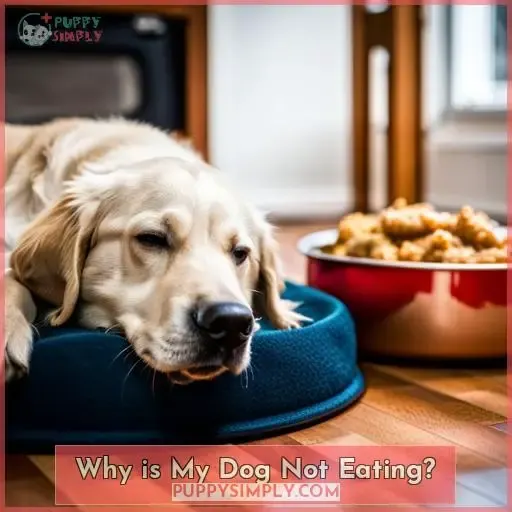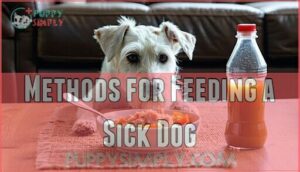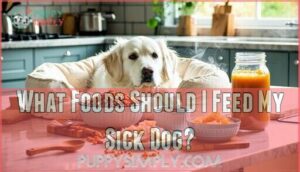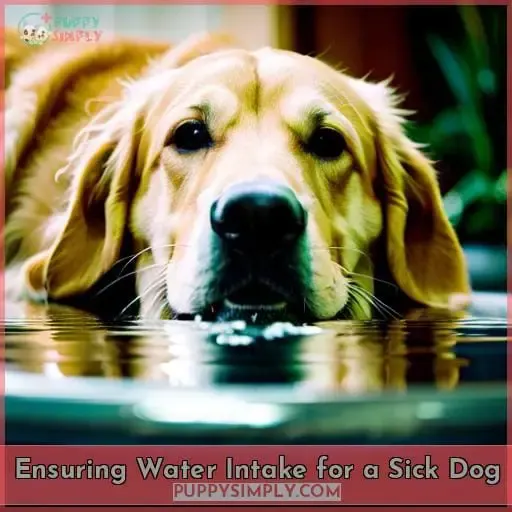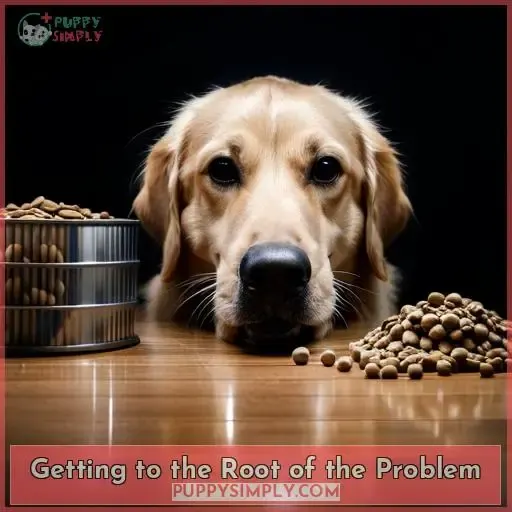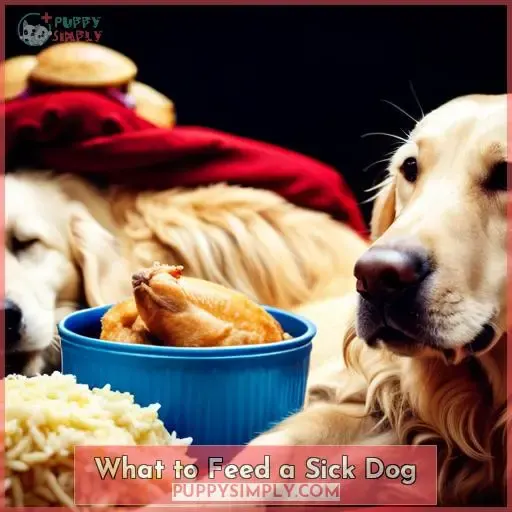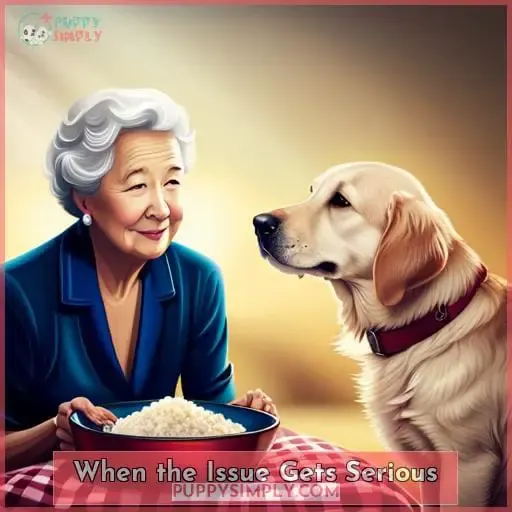This site is supported by our readers. We may earn a commission, at no cost to you, if you purchase through links.
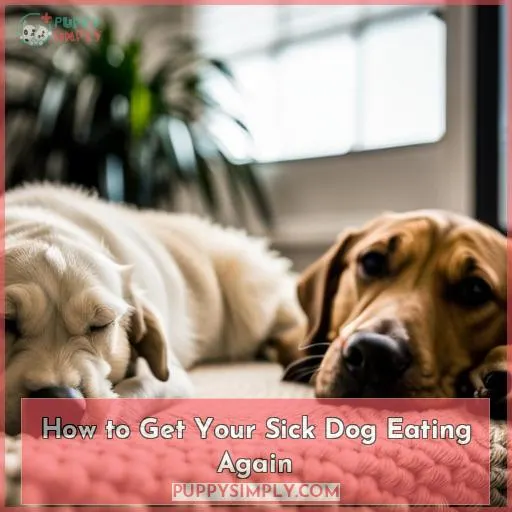 Panic and despair can consume you when your beloved pup is unwell and won’t eat. Not only are they in pain, but their food refusal could lead to further complications if left untreated. It’s a common problem for pet owners to face, so don’t fret; there are ways to get a dog to eat when sick! From changing up their diet with treats or baby food, heating the meal up, or adding broth – these simple methods may help increase appetite.
Panic and despair can consume you when your beloved pup is unwell and won’t eat. Not only are they in pain, but their food refusal could lead to further complications if left untreated. It’s a common problem for pet owners to face, so don’t fret; there are ways to get a dog to eat when sick! From changing up their diet with treats or baby food, heating the meal up, or adding broth – these simple methods may help increase appetite.
With patience and understanding, we can encourage our pooches back on track towards healthiness once again.
Table Of Contents
- Key Takeaways
- Why is My Dog Not Eating?
- When to Contact Your Vet
- Methods for Feeding a Sick Dog
- What Foods Should I Feed My Sick Dog?
- Ensuring Water Intake for a Sick Dog
- What to Do After 48 Hours
- Getting to the Root of the Problem
- Time is a Healer
- What to Feed a Sick Dog
- When the Issue Gets Serious
- Frequently Asked Questions (FAQs)
- Conclusion
Key Takeaways
- Stress, diet changes, digestive issues, and immune system imbalance can cause appetite loss in dogs.
- Signs of concern include not eating for 48 hours, vomiting, diarrhea, lethargy, and dehydration.
- Immediate veterinary attention is necessary if there is suspected dehydration, no eating after 48 hours, or vomiting/diarrhea.
- Veterinary treatment options may include diagnostic tests, diet recommendations, appetite stimulants, and medications.
Why is My Dog Not Eating?
If your pup isn’t interested in chowing down, there could be a few underlying reasons, so it’s important to pay attention to their symptoms and consult with a vet. Anorexia can occur due to stressful events or changes in diet. It’s also possible that digestive issues or an imbalance of the immune system are preventing your dog from eating normally.
To help entice them into eating again, try offering wet food as this has more aroma than dry kibble and may draw their interest back into food again. If they still refuse the food, then lack of appetite could be caused by weight loss due to dehydration.
Look out for signs such as lethargy and reduced skin elasticity when pinched between fingers. If this is suspected, contact your vet immediately for advice on rehydrating them safely before attempting any further dietary changes.
When to Contact Your Vet
You should always contact your vet if your pup is not eating after 48 hours or exhibiting concerning symptoms such as listlessness, vomiting, and diarrhea – signs that can quickly lead to dehydration. A diagnosis from a professional will ensure the best treatment plan for getting them back to eating normally.
They may suggest dietary changes or appetite stimulants like chicken broth, wet food with added flavorings, treats, or trying hand-feeding.
It’s important to follow instructions carefully when administering any medication given by a vet – give food 10-15 minutes before if prescribed with food – and keep an eye out for potential side effects such as nausea, which might prevent them from wanting to eat anything at all! If so, try giving anti-nausea medications, but make sure you visit the vet first before making any major diet alterations or feeding human meds too.
Hydration levels are critical in this situation, so take extra care in ensuring they get enough fluids throughout their recovery period until they start feeling better again!
Methods for Feeding a Sick Dog
If your dog is sick, it can be difficult to get them to eat. To help entice eating, try waiting 12+ hours after vomiting and then giving treats or trying different brands of dry food that is heated with added broth.
You may also want to hand-feed small amounts of baby food or pumpkin mixed with chicken and rice for extra flavor.
Wait
Wait at least 12 hours after your pup has vomited before attempting to feed them small amounts of food. To entice eating, offer treats, heat the food, add shredded chicken or bone broth, and use positive reinforcement.
If stomach upset persists, try a bland diet like mashed pumpkin with anti-nausea medication if needed. Ensure hydration tips are followed by providing plenty of water and introducing an exercise routine to stimulate appetite.
Give Your Dog a Treat
Try enticing your pup with a tasty treat; you can’t go wrong with an old adage like, A way to a dog’s heart is through its stomach. Offer treats that are different brands or even heated food. Add some broth to wet food and use strong smells such as fish, tuna, salmon, and chicken.
Baby food and pumpkin puree are also good options for hiding pills in foods like cheeses, peanut butter, or liverwurst! Ensure adequate water intake by adding probiotics if needed, while avoiding chocolate, alcohol, onions, etc.
| Foods | Benefits | Notes |
|---|---|---|
| Treats/Heated Food | Stimulates appetite | Variety of types available |
| Broth | Enhances smell & taste | |
| Strong Smells | ||
| Fish/Tuna/Salmon & Chicken |
Change Dry Food Brands
Change up your pup’s diet with different brands of dry food to entice eating. Select a brand that is natural and contains healthy ingredients, considering texture as well. Try adding treats like fish or chicken into the mix for an extra special surprise! Bland diets can be helpful if your dog has an upset stomach; water intake should also remain high during these times of rest and medication.
Heat Up Your Dog’s Food
Heating up your pup’s food can help to entice them to eat, as the warm temperatures and strong aromas are often appealing. Try microwaving a small portion of their dry kibble or wet food with an additive-free broth, fish oils, or pumpkin puree.
Hand feeding is another way to get them interested in eating if they’re feeling under the weather; it adds a special touch that will make them feel comfortable and cared for.
Don’t forget about hydration too – adding some extra water into meals helps ensure nutrients are being absorbed while keeping your pup properly hydrated! Chicken and rice also works well when dogs aren’t feeling great; let grass if needed but be sure not to force feed as it may cause further distress.
Add Broth to Your Dog’s Food
Adding broth to your pup’s food can help entice them to eat and provide much-needed hydration. It’s important not to force-feed, as that could lead to choking or other health risks.
Broth is also an appetite stimulant. If your dog doesn’t have one due to being ill, this can be a great way of encouraging eating.
To ensure success when feeding sick dogs, use these hydrating tips. But make sure you always consult with a vet first if any concerning symptoms arise.
What Foods Should I Feed My Sick Dog?
When your dog is sick, it can be difficult to get them to eat. One way you can help is by offering wet food that has been microwaved, baby food, bone broth or chicken broth, and shredded chicken. All of these foods are nourishing and easy on the stomach for a pup who isn’t feeling its best.
Wet Food
Try offering your pup wet food, such as tuna or salmon, to entice eating and make meals more enticing for them. Slow-cook high-protein fish-based wet food with fresh meat for an extra tasty meal. Heat up the meal if necessary, as cold foods can reduce appetites in dogs. Alternatively, you can force-feed with a syringe – but only under veterinary guidance – or use appetite stimulants prescribed by the vet if required.
Baby Food
Offer your pup some baby food to entice eating, and watch as their eyes light up at the smell of something tasty. Baby food can provide a variety of nutrients that help stimulate appetite and encourage hydration.
If your dog has lost its appetite or is showing signs of dehydration, contact a veterinarian immediately for proper dosages and advice on force-feeding risks.
Remember that introducing new foods while sick should always be done under veterinarian guidance to avoid further sickness or complications.
Bone Broth
Serving up a bowl of bone broth could be just the ticket to perk your pup’s appetite when they’re feeling under the weather. Not only is this broth filled with nutrition, it can also provide hydration benefits that help prevent illness.
Natural dog food like raw meat and neat are great dietary options for dogs too, but make sure you plan their diet carefully as there are certain foods that should be avoided.
Bone broth has all these benefits plus plenty more, so get cooking today for a healthier tomorrow for your pooch!
Chicken Broth
Consider adding chicken broth to your dog’s meals, as it can provide hydration and nutrients while also enticing them to eat. Chicken broth is a great way to help keep your pup hydrated if they are ill or not eating due to stress.
It will also reduce the risk of force-feeding, and anti-nausea medications may become unnecessary with its consumption.
Shredded Chicken
Try shredding some chicken for your pup – it’s a great way to get them interested in eating again. A bland diet can help prevent dehydration and nourish an injured dog or one with intestinal issues. Make sure the chicken is cooked thoroughly, and avoid unhealthy foods like raw eggs, chocolate, or garlic.
Use cooking tips, such as adding broth, to make meals more palatable. This also provides food variation instead of sticking with kibble all the time. Probiotics may help too. Consider giving water between meals if signs of dehydration appear (loss of appetite, etc.
Ensuring Water Intake for a Sick Dog
It is important to ensure water intake for a sick dog. Look out for signs of dehydration such as loss of appetite, lethargy, and dry gums, nose, or eyes. Avoid feeding your pup chocolate, alcohol, raw eggs, or other human foods that can be harmful to their health.
How to Encourage Water Intake
Encourage your pup to stay hydrated by offering a variety of water sources and flavors. Place multiple bowls around the house so they can drink whenever they need throughout the day.
Ask your vet for advice about digestive issues or medications like Pepcid AC that may be beneficial if your pooch is dealing with nausea or an upset stomach.
In addition, offer small portions of low-sodium foods such as scrambled eggs and easily digestible proteins like boiled chicken breast.
If these choices don’t entice them to eat, you should consult a veterinarian before introducing human medicines into their diet as this could lead to further complications down the line!
Signs of Dehydration
Be mindful of dehydration signs in a sick dog, such as loss of appetite and lethargy. Look out for dry gums, nose, or eyes as these are indicators of dehydration. It is important to prioritize hydration for the sake of your dog’s health.
Encourage water intake by offering frequent small meals and bland diets if the stomach is upset. To stimulate appetite, consider using elevated feeders or snuffle mats during exercise. If necessary, consult a vet for guidance on force-feeding, but remember to avoid self-reference.
If your dog shows signs of vomiting before consuming more food or medication, contact a vet immediately as this could be a sign of dehydration.
What Not to Feed a Dog
Avoid feeding your pup chocolate, alcohol, onions, garlic, grapes, raisins, macadamia nuts, and other no-go’s – your furry friend will thank you!
Not only can these foods cause food allergies or diet changes that are hard for them to handle, but they could also lead to stomach upset.
Variety in texture and flavor is key when it comes to their meals. Try baby food mixed with different meats like chicken or fish broth.
You should also regularly change up the type of food you give them as this helps keep things interesting while still providing all the important nutrients they need.
Don’t forget water too – make sure there is always plenty available so dehydration doesn’t become an issue!
What to Do After 48 Hours
If your dog has been sick for more than 48 hours and isn’t eating, don’t worry! There are a few options you can try to get them back on track. Try giving them 1/4 Tab of Original Pepcid AC to help stimulate their appetite; this may also be helpful in hiding the pills if necessary.
Get creative with tempting treats or meals that they haven’t had before. Remember, patience is key! As an additional tip, it’s worth visiting your vet as soon as possible so they can guide you through safely and effectively helping your pup regain their appetite.
Trying a 1/4 Tab of Original Pepcid AC
If your pup is still having trouble eating after 48 hours, try giving a 1/4 tab of Original Pepcid AC. It’s important to consult with your vet to ensure the proper dosage and timing for administering this medication.
Be aware that there are potential drug interactions as well as side effects like stomach upset, so it’s best to get professional advice first.
Additionally, make sure you monitor hydration levels while using this drug. If symptoms persist or worsen, seek veterinary care immediately. Following these guidelines can help reduce risks associated with using medications such as Pepcid AC in dogs who may be suffering from an inability or unwillingness to eat due to changes in health status or stress-related issues.
Whet the Appetite
Try enticing your pup’s appetite with treats, different brands of food, or even heated meals to stimulate their taste buds. Incorporate exercise into their day-to-day routine, which will help enhance the stimulation and increase hunger.
If they’re feeling ill, offer a bland diet that’s easy on their stomach, such as chicken and rice. Consider warming up the food before feeding it to them if needed. Smearing baby foods onto kibble may also help entice eating habits.
For more serious cases where they’re vomiting, consider anti-nausea medication prescribed by a vet before attempting any other methods of getting them to eat again.
Hide the Pills
Hide pills in your pup’s favorite snack – like cheese, peanut butter, or liverwurst – to make sure they get the medication their vet prescribed.
Did you know that a dog’s senses of smell and taste are around 10-100 times stronger than ours? Avoid force-feeding as it can be risky; instead, try hiding the pill in something yummy.
Smear baby food on top or microwave wet food for more enticing smells. Offer treats and different brands of food to find what your pup likes best!
Be aware of dehydration signs such as loss of appetite, lethargy, dry gums/nose/eyes.
With patience and understanding, we can ensure our pups stay healthy!
Get Creative
Get creative with your pup’s meals – think outside the bowl by adding tasty treats, strong smells, or even warm, hand-fed baby food. Keep an eye out for hydration signs like loss of appetite and dry gums, nose, or eyes to ensure they’re getting enough liquid.
Avoid human meds and foods full of sugar, salt, or caffeine that can be harmful to their health. Consult a vet before changing the diet if on special food, as well as introducing new foods when sick.
Patience Wins the Day
Take your time when helping a sick pup to eat; patience is key. Create a supportive environment and prioritize hydration needs, but do not force feeding. Consider dietary changes such as wet food or special diets with vet guidance. You can entice eating with treats, strong smells, baby food, and pumpkin in moderation.
Ensure exercise too! Be mindful of foods to avoid like chocolate and salt while administering medications carefully according to directions. If the dog isn’t eating after 48 hours, contact the vet immediately for advice and watch out for signs of dehydration like lethargy, dry gums, nose, and eyes, which require urgent attention from your veterinarian.
Do all you can without stressing yourself or the pup: love will go a long way towards achieving health goals together!
Bonus Tip: Visit the Vet
Visit your veterinarian for guidance if your pup isn’t eating after 48 hours or is showing concerning symptoms like vomiting, lethargy, and diarrhea. Seek medical attention immediately if dehydration signs are present, such as loss of appetite, dry gums, eyes, or nose.
Offer warm food to entice them; add smelly ingredients like salmon and tuna broth to encourage consumption. Comfort your dog, but don’t stress him out further by hand-feeding or hiding pills in foods.
You should avoid giving chocolate, garlic, onions, grapes, etc. Avoid changing their diet without vet advice too! Lastly, ensure adequate exercise and hydration for recovery.
Getting to the Root of the Problem
Investigate the underlying cause of your pup’s sickness to get them back to eating normally. When a dog stops eating, it’s important not only for their health but also their comfort and safety that you understand why this has happened.
Monitor symptoms such as vomiting, lethargy, and diarrhea carefully and seek veterinary help if they persist longer than 48 hours or worsen in any way. Diet changes should be made after consulting with a vet due to potential risks associated with force-feeding.
Instead, try comforting your pet while offering treats like heated food or different brands of wet food, which may encourage them more successfully than regular kibble alone.
Additionally, ensure hydration by providing plenty of water along with monitoring symptom severity.
Lastly, always prioritize getting professional medical advice before making drastic diet changes or administering medications.
Time is a Healer
Give your pup some time to rest and heal, as this can be all it takes for them to start eating again. Comforting your dog can also help motivate their appetite; a gentle massage or brushing of their fur may do the trick! Make sure they’re getting plenty of exercise – if you have an usual routine, stick with it as much as possible.
Monitor any dehydration signs like lethargy, dry gums/nose/eyes, and loss of skin elasticity – seek vet help immediately if these are present. Be mindful about what they eat by avoiding human foods such as chocolate, alcohol, and spices that could cause more harm than good.
What to Feed a Sick Dog
When your furry friend is feeling under the weather, there are a few things to keep in mind. To ease their discomfort and encourage them to eat, you can try giving treats specifically for sick dogs or using simple methods like hand-feeding.
If they need medicine, it’s important to follow dosage instructions carefully so that food doesn’t interfere with the absorption of medication.
Giving Sick Dogs Treats
Try offering your pup some treats to entice them into eating, such as pungent wet food or microwaveable snacks. Benefits of giving treats include added nutrition, hydration, and flavor for palatability.
Types of treats range from rawhide chews to crunchy biscuits; make sure all ingredients are safe for dogs before serving! Store opened packages in an airtight container, discard after the expiration date, and keep them away from pets’ reach when unattended.
Treats can also provide mental stimulation with puzzles or snuffle mats—fun for both you and your four-legged friend! Keep in mind that sick dogs may need bland diets, so check with a vet first if introducing new foods while they’re unwell.
Simple Methods to Reintroduce Food to Sick Dogs
Reintroduce meals to your pup gradually when they aren’t feeling their best, as small portions of familiar foods can help stimulate appetite and also comfort them. Consider medicinal needs and home remedies while ensuring sufficient water intake.
Supportive care with different diets such as bland food or warm baby food may be necessary.
Include probiotics for digestion issues, but always consult the vet before changing the diet if the pup is on special food or force feeding. Make sure exercise continues to encourage appetite while avoiding all human meds and forbidden snacks like chocolate and onions.
Lastly, check skin elasticity for signs of dehydration, which requires immediate vet attention.
Giving Dogs Medicines
When caring for a sick dog, consider giving medicines carefully according to the instructions provided and with food if prescribed. Medication dosages should be followed closely. Provide it with a meal or snack if needed.
If your pet is experiencing stomach upset due to medication, try feeding bland foods that are easy on their tummy like white rice mixed in with boiled chicken breast shreds. Anti-nausea medications may also help reduce vomiting so they can keep food down better while taking medicine.
Always read labels or consult your vet before providing any type of over-the-counter medication. Some can have adverse effects on animals when taken incorrectly or without proper supervision from an experienced professional veterinarian that specializes in animal care and nutrition.
When the Issue Gets Serious
If symptoms such as vomiting, lethargy, or diarrhea persist after 48 hours, it’s essential to contact a vet for advice and prioritize hydration. Make sure to carefully read the medication dosage before feeding it to your dog.
If prescribed by the vet, food should be given 10-15 minutes prior to medication. If your dog is having difficulty eating due to vomiting episodes, anti-nausea medication may help stimulate their appetite.
Signs of dehydration include loss of appetite, lethargy, and dry gums, eyes, and nose. Therefore, it’s crucial to ensure that your pup’s water intake remains high. If you suspect dehydration, seek immediate medical attention.
Before attempting force feeding, consult a professional as it can have associated risks. During this time, it’s important to comfort your dog without stressing them out. Puzzle toys or snuffle mats may help keep their minds occupied while they try to regain their nutritional balance.
Frequently Asked Questions (FAQs)
What medications should I give my dog when they are sick?
Have you ever wondered what medications to give your dog when they are sick? Consult a vet before administering any new drugs. Ensure that the instructions are read carefully and administered properly to avoid danger.
Take preventative measures with probiotics and anti-nausea medication for vomiting, if needed.
How can I tell if my dog is dehydrated?
Signs of dehydration in your dog include loss of appetite, lethargy, dry gums, nose, and eyes, and lack of skin elasticity. Seek vet help immediately if you notice these symptoms; water intake is critical.
Are there any foods I should avoid giving my sick dog?
Avoid giving your sick pup chocolate, alcohol, onions, garlic, grapes/raisins, and macadamia nuts. Raw eggs and caffeine are also off-limits, as well as any sugar or spices. Bones and salt can be dangerous too, so it’s best to steer clear of these! Milk and human medications should never be given either.
What are some ways to entice my dog to eat?
Entice your pup to eat with treats, warm foods, smell-enhancers like fish and chicken broth or baby food. Try puzzles and snuffle mats for meals. Small and frequent may be better than big portions.
How can I tell when the issue has become serious?
If your dog isn’t eating, seek veterinary help after 48 hours. Signs of dehydration, such as dry gums and loss of skin elasticity, can be serious. Contact a vet immediately if you spot them. Offer different treats to entice eating, exercise to stimulate appetite, and anti-nausea medication if needed.
Conclusion
It’s heartbreaking to see your beloved pup sick and refusing to eat. But with a little patience, knowledge, and care, you can get your pup back to their healthy, happy self in no time! Remember, time is a healer, and if your pup isn’t eating after 48 hours, it’s critical to contact your vet.
But before that, try to entice your pup by offering treats, different brands, heated food, added broth, or even hand-feeding. Also, make sure to avoid giving them anything like chocolate, onions, or garlic.
With a little bit of TLC and some creative ideas, you can get your sick pup eating again in no time.

